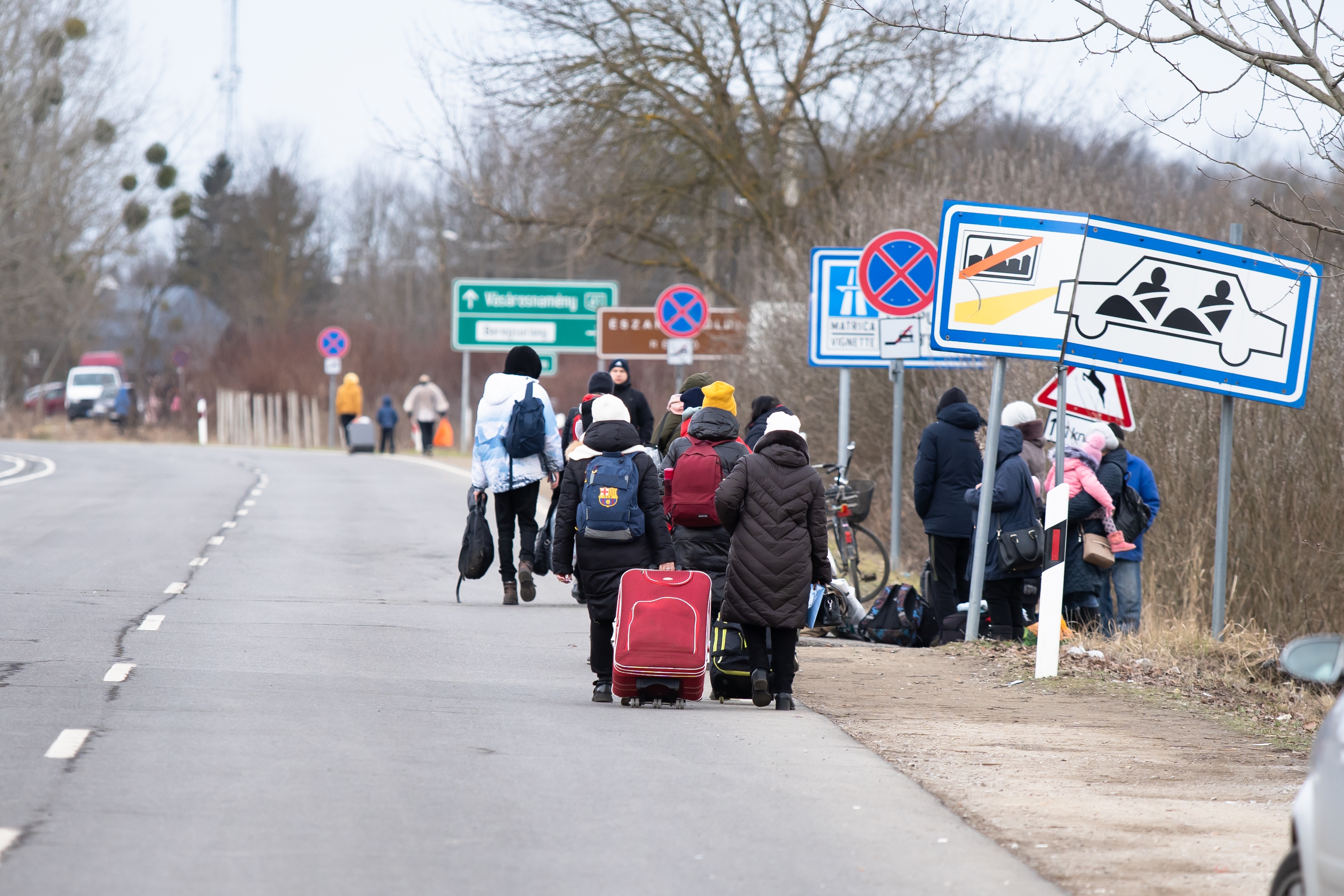NATO and the U.S. have provided Ukraine with hundreds of millions of dollars worth of weapons just in the last few weeks. Ukrainian soldiers credit the aid with helping them to resist a much larger Russian military. Retired Lt. Gen. Doug Lute, who had a 35-year career in the U.S. Army, served on the National Security Council staff and was ambassador to NATO, joins Nick Schifrin to discuss.

As a nonprofit journalism organization, we depend on your support to fund coverage of global conflicts. Help us continue funding the hard costs of in-depth coverage of the Ukraine invasion—including travel, hostile environment safety training, and the increased security expenses that arise from reporting in war zones.
Read the Full Transcript Below
Judy Woodruff: And to examine that military — that is, that American and NATO military assistance that Jane was discussing with the soldier outside of Kyiv, we turn now to Nick Schifrin, who has returned to the U.S. after spending weeks in Ukraine.
Nick Schifrin: Judy, NATO, and the U.S. have provided Ukraine with hundreds of millions of dollars worth of weapons just in the last few weeks.
As you just heard, Ukrainian soldiers credit the aid in helping them resist a much larger Russian army. How have they done that? And will the additional assistance President Biden announced yesterday change things on the ground?
To discuss that, we turn again to retired Lieutenant General Doug Lute, who had a 35-year career in the Army, served on the National Security Council staff in the George W. Bush and Obama administrations, and was President Obama's ambassador to NATO.
Doug Lute, welcome back to the program.
President Biden's announcement yesterday was the largest single military infusion to Ukraine since the war began. For the first time, it includes these, kamikaze drones that have a six-mile range and can explode on impact, and it includes 1,000 anti-tank Javelins that you can see here Ukrainian soldiers have used so effectively right there to pick off Russian tanks that have bunched up on roads.
What's the impact of this new package?
Lt. Gen. Douglas Lute (Ret.), Former U.S. Ambassador to NATO: Well, Nick, first of all, the $800 million, which was just approved, of course, totals out over last year — brings that total to $2 billion worth of U.S. military assistance.
And, of course, that $2 billion U.S. is on top of the contributions of some 30 countries total. So, just by way of quantity, yesterday's announcement was an important step, but very much continues in the pattern of the last year.
The quality difference, though, is significant, so, first of all, these, for the first time, armed drones, which essentially extend and double the range of the Javelin, so from about one or two miles out for the Javelin, and up to six for the armed drones. That's significant.
However, those drones were only provided — there are only about 100 of those. So, I would like to see many more of those going forward.
Nick Schifrin: One thing Ukraine has talked about, of course, is air defense. They want a no-fly zone. That's not going to happen. But the U.S. is providing more air defenses, including Stingers, which we have seen, again, Ukraine use so effectively like this. That is a helicopter being hit by a Stinger.
Stingers can hit helicopters and even low-flying jets. And U.S. officials tell me they're trying to facilitate more advanced air defense systems, including systems that were originally created by the Soviet Union known as SA-8s, and the more advanced S-300s.
Why is that so important?
Lt. Gen. Douglas Lute: Well, this is a way to impose a no-fly zone, but imposing it from the ground, as opposed to trying to control it from the air with NATO aircraft.
The Ukrainians have some systems now. We mentioned the Stinger. Yesterday's package announced by the president included hundreds of more Stinger missiles. That's great. But, as you say, these are relatively short-range.
The good news is, that among our 30 NATO allies, there are some allies who still have Soviet vintage equipment, with which the Ukrainians are very familiar, so no training required. They know how to maintain these systems and so forth.
So now the path forward is to get these Soviet vintage air defense systems from U.S. allies into the hands of the Ukrainians, and then backfill the allied systems with more modern systems. So, this is really a two-edged advantage for us. We get the right systems into the hands of the Ukrainians and we up-arm our own allies.
Nick Schifrin: And those systems should allow Ukraine to at least target, if not hit, Russian missiles and perhaps jets flying at a higher elevation.
But we've seen another tactic, of course, in the last few days, last week or so, Russian troops moving around less, in part because of these American and NATO weapons, and using artillery more to, unfortunately, great effect.
You can see the worst effects of that kind of artillery in Mariupol. It's scorched earth, clearly targeting civilian neighborhoods in an indiscriminate way.
Now, the U.S. has sent some artillery rounds to Ukraine. But can the U.S., NATO weapons that they've provided to Ukraine really stop this Russian artillery?
Lt. Gen. Douglas Lute: The way to attack these Russian artillery systems — and I think what you see there in Mariupol, by the way, is just a prototype.
It's an early example of the Russian campaign plan to besiege the larger Ukrainian cities, so Kyiv and Kharkiv in the east. But the way to attack this siege campaign is by way of attacking its supply lines. And, here, the systems that the U.S. is providing now to the Ukrainians, to include the additional systems announced yesterday, are effective ways to get at the supply lines.
The supply lines run out of Belarus and out of Russia itself. They're long. They're vulnerable. They're not well-guarded. They're largely road-bound. And the Javelins and the Stingers are perfect systems to take the fight to those supply lines.
Nick Schifrin: Zooming out, we were speaking to you earlier today, and you told us that these weapons, while exacting a higher cost on the Russians, will not be decisive. Explain that.
Lt. Gen. Douglas Lute: Yes, I'm afraid we're actually headed towards a stalemate, with the Russians having a lot of firepower, and the Ukrainians, enabled by us with the kind of systems that the president announced yesterday, but not — these systems are not going to prove a decisive edge for our Ukrainian partners.
You know, at the end of the day, Nick, even in a prolonged stalemate, typically, willpower on behalf of the Ukrainians will probably defeat, in my view, the firepower of the Russians. And that, I think, unfortunately, in this prolonged, brutal conflict that lays ahead will be the equation.
Nick Schifrin: And, Doug, I have only got about 40 seconds left, so quickly.
Is there a risk of escalation, do you think, as the U.S., as NATO provides more weapons?
Lt. Gen. Douglas Lute: Of course.
I mean, one of the tactics that we haven't seen the Russians use yet is to try to interdict NATO supply lines. And, of course, those supply lines begin in NATO countries themselves along the western border with Ukraine. So, if Russia were to try to assemble an interdiction campaign, that moves that campaign much closer to NATO borders. And that's one risk of escalation.
Nick Schifrin: Doug Lute, appreciate it, as always. Thanks very much.
Lt. Gen. Douglas Lute: Thanks, Nick.







